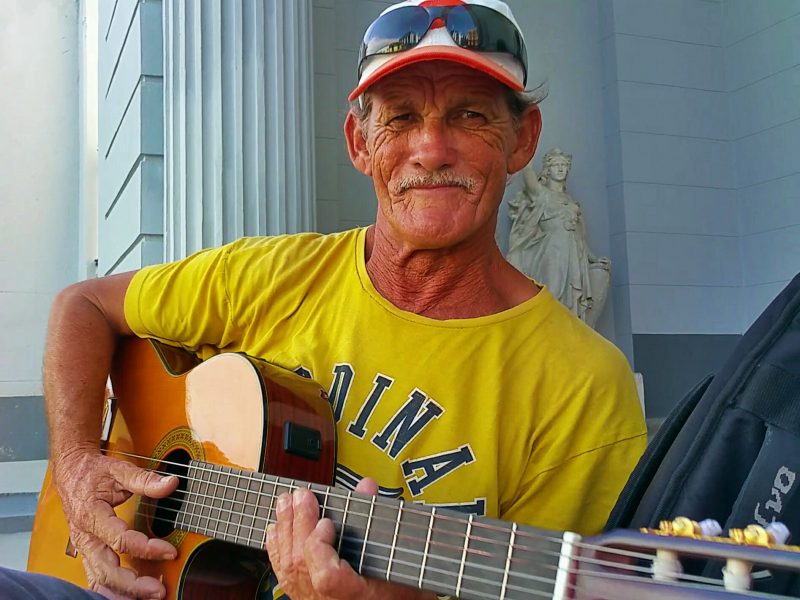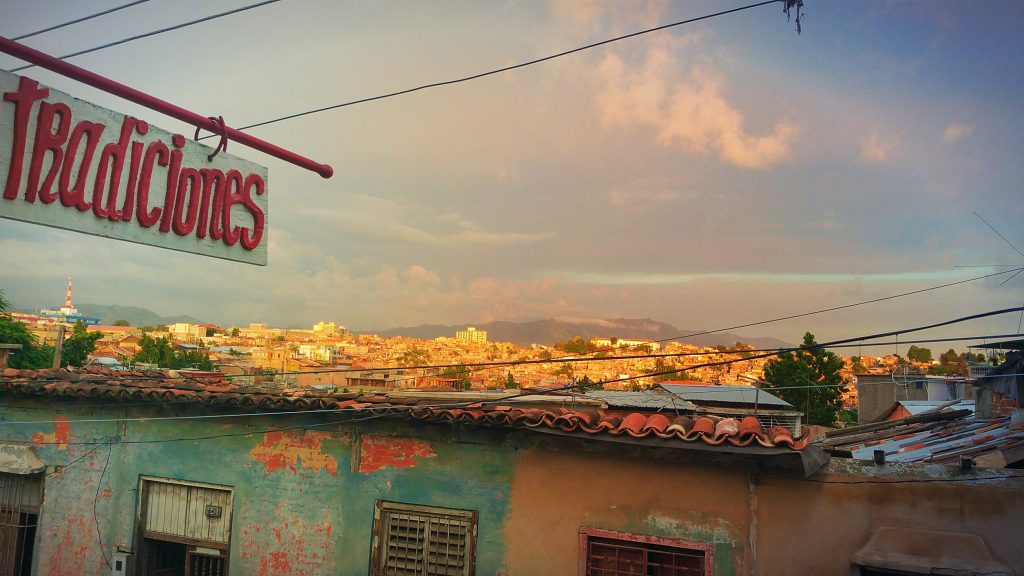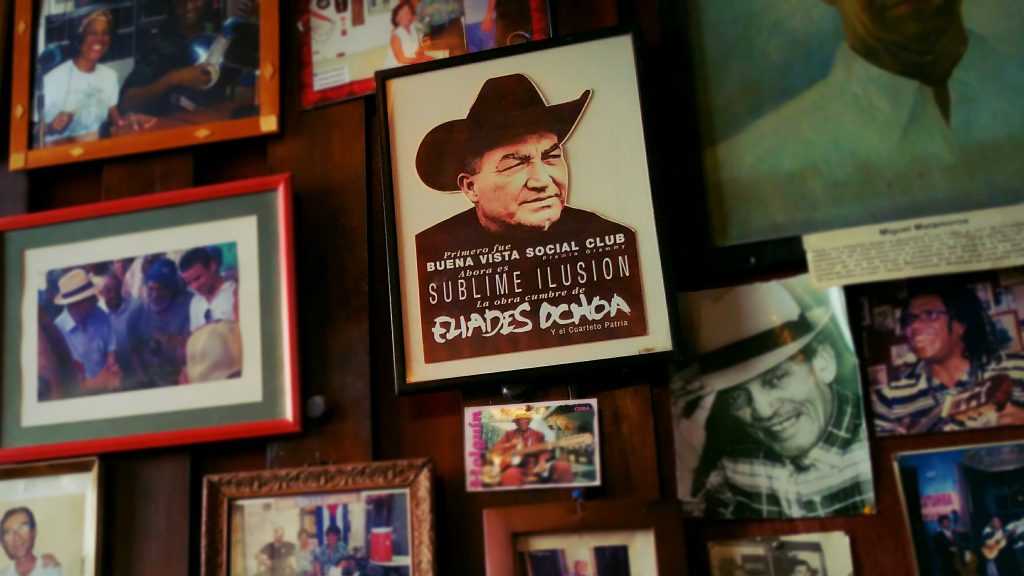Filin Guitar | Jazzin’ Up the Bolero

[vc_row][vc_column][vc_column_text]
After meeting Los Jubilados del Caribe yesterday, I return to the scene of the crime for my first lesson with Rudy.
As I arrive, Los Jubilados are packing up for the day. We exchange high fives and phrases in exaggerated Cuban accents, then Rudy and I take a seat on the steps beneath the colonnades of the Emilio Bacardí Museum.
Rudy asks me what I’d like to learn.
I wonder: where exactly should you begin with a musician who has such a big bag of tricks?
We had begun a conversation at Casa de las Tradiciones about the style of bolero he was playing that night but it was cut agonisingly short. His style sounded quite different from Xiomara’s more traditional feel, so I’m eager for him to spill the beans.
What is this style? And what are the little tricks that he uses to make it sound so lush?
[/vc_column_text][/vc_column][/vc_row][vc_row][vc_column][vc_custom_heading text=”Bolero vs. Filin” font_container=”tag:h1|text_align:center” use_theme_fonts=”yes” css=”.vc_custom_1460263839794{margin-top: 0px !important;}”][vc_custom_heading text=”‘Cómo Fue'” font_container=”tag:h4|text_align:center” google_fonts=”font_family:Lobster%3Aregular|font_style:400%20regular%3A400%3Anormal” css=”.vc_custom_1461033800901{margin-top: 0px !important;}”][vc_column_text]
Rudy explains that the style he was playing is a freer form of bolero called filin. It emerged in the 1940s as Cuban music began to cross-pollinate with US jazz.
He will begin today’s lesson by demonstrating the differences between bolero and filin, using one of the most popular songs at Casa de las Tradiciones.
The Cuban classic, ‘Cómo Fue’ (‘How It Was’), was written by Cuban composer Ernesto Duarte Brita. The most famous interpretation of the song was by legendary Cuban singer Benny Moré.
[/vc_column_text][vc_video link=”https://youtu.be/wfDBd7iwJ34″][vc_column_text]
As me and Rudy run through the song, practicing how to add rhythmic lulls, melodic flurries and harmonic vistas, it becomes quite obvious how close this filin style is to his heart.
I sensed this same passion charging the atmosphere at Casa de las Tradiciones. Many of Rudy’s peers there, such as former professional singer María, will have been part of the filín generation. And the quality of María’s performance makes me wonder: just how deeply was she involved in the scene and what was it like?
I’m eager to discover more about the origins of this phenomenon and to gain some insight into how it may have influenced Rudy’s youth, as well as others at the peña like María and Alfredo.
[/vc_column_text][/vc_column][/vc_row][vc_row][vc_column][vc_custom_heading text=”The Filin Movement” font_container=”tag:h1|text_align:center” use_theme_fonts=”yes” css=”.vc_custom_1460264667271{margin-top: 0px !important;}”][vc_custom_heading text=”Jazzin’ It Up” font_container=”tag:h4|text_align:center” google_fonts=”font_family:Lobster%3Aregular|font_style:400%20regular%3A400%3Anormal” css=”.vc_custom_1461033823000{margin-top: 0px !important;}”][vc_column_text]
In the 1940s, before the Cuban Revolution and the US blockade, young Cubans were attracted to Havana’s docks where there were jukeboxes and American sailors bringing new music styles with them. Here they could enjoy the latest sounds from the States and try out new dance styles.¹
One of those young Cubans was Angel Diaz, son of Cuban trovador, Tirso Diaz. His father was a good friend of Rosendo Ruiz, one of the founding fathers of the trova style. And as such, Angel and his younger brother Tirso Jnr. were childhood friends of Rosendo Ruiz Jnr.
After meeting technically-gifted guitarists like Cesar Portillo de la Luz and Jose Antonio Méndez, they began to form a musical clique. They jammed and exchanged ideas at the now famous Diaz residence on Callejon de Hammel in the Cayo Hueso barrio of Havana.
They played old trova songs, adding their own generation’s youthful twists. They were searching for ways to make the bolero less formal; less rigid in its lyrical and rhythmic structure. As is rare in Cuba, this style was not attached to a dance form, being in free-time. It was more about contemplation and free-form expression.
The style gave guitarists more artistic freedom, with singers guiding them subliminally through body language and subtle changes in tone. Together, these filinistas could shift the fabric of time, opening up sonic voids which acted as a metaphor for feelings of emptiness.
A diverse mixture of musical characters began to gather at the Diaz residence, which would provide the perfect blend of grassroots creativity and technical depth:
[/vc_column_text][vc_row_inner][vc_column_inner width=”1/2″ css=”.vc_custom_1461043916426{padding-right: 5px !important;padding-left: 5px !important;background-color: rgba(0,0,0,0.15) !important;*background-color: rgb(0,0,0) !important;}”][icon_feature title=”Grassroots Singers & Musicians”]
Largely untrained musicians provided the raw material with youthful spirit.²
They had been influenced directly by the original trova pioneers of the bolero.
[/icon_feature][/vc_column_inner][vc_column_inner width=”1/2″ css=”.vc_custom_1461043946234{padding-right: 5px !important;padding-left: 5px !important;background-color: rgba(0,0,0,0.15) !important;*background-color: rgb(0,0,0) !important;}”][icon_feature title=”Arrangers & Musical Mentors”]
Arrangers Peruchín, Bebo Valdes & Niño Rivera offered access to advanced approaches.²
Formed part of parallel development of latin jazz with US artists such as Nat King Cole & Dizzy Gillespie.³
[/icon_feature][/vc_column_inner][vc_column_inner][/vc_column_inner][/vc_row_inner][vc_column_text]
This well-balanced group then began to craft their own songs. They were more intimate, full of poetic imagery and sentimentality. More complex harmony and melody helped to convey an added sense of depth and intensity.
They stumbled upon a name for this style: filin.
[/vc_column_text][vc_column_text css=”.vc_custom_1592820280624{padding-top: 5px !important;padding-right: 5px !important;padding-bottom: 5px !important;padding-left: 5px !important;background-color: rgba(0,0,0,0.15) !important;*background-color: rgb(0,0,0) !important;}”]
‘When we were dancing [to English language songs], we kept hearing ‘feeling’. Once we found out what it meant, we started using it – you have feeling or you don’t. Whatever had our sensitivity, had feeling.’¹ Angel Diaz
[/vc_column_text][vc_column_text]
One of Rudy’s favourite filín songs is the beautiful ‘Contigo En La Distancia’ by César Portillo de la Luz.
[/vc_column_text][vc_row_inner][vc_column_inner][vc_video link=”https://youtu.be/z2LAMN7umKg” align=”center”][/vc_column_inner][/vc_row_inner][/vc_column][/vc_row][vc_row][vc_column][vc_custom_heading text=”Filin Guitar” font_container=”tag:h1|text_align:center” use_theme_fonts=”yes” css=”.vc_custom_1461128222799{margin-top: 0px !important;}”][vc_custom_heading text=”Vital Ingredients & the Role of the Guitarist” font_container=”tag:h4|text_align:center” google_fonts=”font_family:Lobster%3Aregular|font_style:400%20regular%3A400%3Anormal” css=”.vc_custom_1461037010863{margin-top: 0px !important;}”][vc_column_text]
The acoustic guitar, which had served solo trovadors so well in the early 20th century, had been falling out of favour following the rise of bigger ensembles with loud brass and wind instruments.
This new filin style provided a technical finesse and emotive power, which reignited the guitar’s strengths.
[/vc_column_text][vc_tta_tabs style=”modern” spacing=”3″ gap=”3″ alignment=”center” active_section=”1″ pagination_style=”outline-round” pagination_color=”black” css=”.vc_custom_1461040833888{background-color: #ffffff !important;}”][vc_tta_section i_icon_fontawesome=”fa fa-tachometer” add_icon=”true” title=”Tempo” tab_id=”1461029452793-af3d5ceb-93be”][vc_column_text]
Rubato time feel (Italian term with the literal meaning ‘stolen time’)
Brisk flurries and suspense-filled voids add excitement and anticipation.
The tempo and rhythm become more lyrical, almost imitating speech.
[/vc_column_text][/vc_tta_section][vc_tta_section i_icon_fontawesome=”fa fa-music” add_icon=”true” title=”Melody” tab_id=”1461029453757-2f3896f1-444f”][vc_column_text]
Chromaticism (adding adjacent notes which don’t belong to the parent scale).
Melodies are picked out around the chords, decorating the space left by the vocals.
These runs are found in the bass strings as well as the higher strings.
Chromatic notes give a sense of ambiguity and allow for dramatic ascents and descents.
[/vc_column_text][/vc_tta_section][vc_tta_section i_icon_fontawesome=”fa fa-random” add_icon=”true” title=”Harmony” tab_id=”1461029820147-69e0b948-d96e”][vc_column_text]
Extended Harmony & Modulation
Chords are enriched and dramatised by adding extensions (7ths, 9ths, 11ths, 13ths).
Complex jazz chord progressions and modulations create unexpected twists and turns in the story.
[/vc_column_text][/vc_tta_section][/vc_tta_tabs][/vc_column][/vc_row][vc_row][vc_column][vc_column_text]
I have seen the role of the guitarist vary in Cuban music, depending on the size of the ensemble.
In filín, the role is similar to a solo trovador. But in this context, whether guitarists are backing themselves or a singer, they’re expected to give more; to expose their ‘feelings’ and ‘lose themselves’ in the performance.
Rather than merely reacting to a singer in a methodical way, an accompanying guitarist must constantly absorb what the singer is trying to convey, then mirror and deepen that sentiment in their playing.
Rudy is certainly a master in this fine art and I feel privileged to have him as a mentor.
[/vc_column_text][/vc_column][/vc_row][vc_row][vc_column][vc_custom_heading text=”Next on the Agenda” font_container=”tag:h1|text_align:center” use_theme_fonts=”yes” css=”.vc_custom_1460263465158{margin-top: 0px !important;}”][vc_column_text]
Rudy has shown me some pretty nifty tricks today and I feel as if these will help improve my expressive playing across all genres. Perhaps in that sense, filin is more of a style or developmental approach than a genre in itself.
I ask him about another song that I enjoyed at Casa de las Tradiciones, which had the whole crowd singing along. It didn’t really sound like a bolero or a filin. The chorus sounded something like ‘Camerera’.
He tells me it’s called ‘Camarera de mi Amor’ (‘Barmaid I Adore’) and he plays it as a bolero-chá.
Ooh, chá? Sounds like a tasty genre that could quench the thirst of millions.
He tells me to drop by tomorrow and we can brew up some nice chá guitar…
[/vc_column_text][/vc_column][/vc_row][vc_row top_margin=”0″ bottom_margin=”0″ css=”.vc_custom_1461016437255{background-color: rgba(0,0,0,0.16) !important;*background-color: rgb(0,0,0) !important;}”][vc_column][vc_custom_heading text=”Further Listening” font_container=”tag:h1|text_align:center” use_theme_fonts=”yes” css=”.vc_custom_1461016415748{margin-top: 0px !important;}”][/vc_column][vc_column][vc_row_inner][vc_column_inner width=”1/3″][vc_video link=”https://youtu.be/1_0T4AX5kOk” align=”center” title=”‘Si Me Comprendieras’ by Jose Antonio Méndez”][/vc_column_inner][vc_column_inner width=”1/3″][vc_video link=”https://youtu.be/YH_jng60ewU” title=”Alvaro Carrillo – one of many Mexican filinistas”][/vc_column_inner][vc_column_inner width=”1/3″][vc_video link=”https://youtu.be/osq0xFTLit4″ align=”center” title=”Ecuadorian interpretation of ‘Hacia Dónde’ by Marta Valdés”][/vc_column_inner][/vc_row_inner][/vc_column][/vc_row][vc_row top_margin=”0″ bottom_margin=”0″ el_id=”citations”][vc_column][vc_column_text]¹ Cuban Music from A to Z | Helio Orovio
² www.ecured.cu
³ Wikipedia en español[/vc_column_text][/vc_column][/vc_row]





